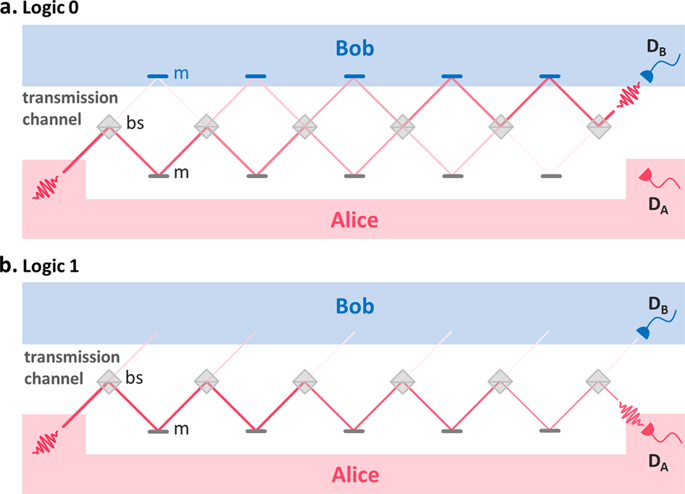npj Quantum Information ( IF 6.6 ) Pub Date : 2019-07-23 , DOI: 10.1038/s41534-019-0179-2 I. Alonso Calafell , T. Strömberg , D. R. M. Arvidsson-Shukur , L. A. Rozema , V. Saggio , C. Greganti , N. C. Harris , M. Prabhu , J. Carolan , M. Hochberg , T. Baehr-Jones , D. Englund , C. H. W. Barnes , P. Walther

|
In standard communication information is carried by particles or waves. Counterintuitively, in counterfactual communication particles and information can travel in opposite directions. The quantum Zeno effect allows Bob to transmit a message to Alice by encoding information in particles he never interacts with. A first remarkable protocol for counterfactual communication relied on thousands of ideal optical operations for high success rate performance. Experimental realizations of that protocol have thus employed post-selection to demonstrate counterfactuality. This post-selection, together with arguments concerning a so-called “weak trace” of the particles traveling from Bob to Alice, have led to a discussion regarding the counterfactual nature of the protocol. Here we circumvent these controversies, implementing a new, and fundamentally different, protocol in a programmable nanophotonic processor, based on reconfigurable silicon-on-insulator waveguides that operate at telecom wavelengths. This, together with our telecom single-photon source and highly efficient superconducting nanowire single-photon detectors, provides a versatile and stable platform for a high-fidelity implementation of counterfactual communication with single photons, allowing us to actively tune the number of steps in the Zeno measurement, and achieve a bit error probability below 1%, without post-selection and with a vanishing weak trace. Our demonstration shows how our programmable nanophotonic processor could be applied to more complex counterfactual tasks and quantum information protocols.
中文翻译:

与纳米光子处理器的无痕反事实通信
在标准通信中,信息是由粒子或波携带的。与直觉相反,在反事实交流中,粒子和信息可以沿相反的方向传播。量子芝诺效应使Bob可以通过将信息编码到他从未与之交互的粒子中来向Alice发送消息。反事实通信的第一个杰出协议依赖于成千上万种理想的光学操作,以实现高成功率性能。该协议的实验实现因此采用了后选择来证明反事实。此后选择以及有关从Bob到Alice传播的粒子的所谓“弱迹线”的论点,导致对该协议的反事实性质进行了讨论。在这里,我们规避了这些争议,实施了新的,与基于纳米波长的可重构绝缘体上硅波导基于可编程纳米光子处理器的协议存在根本不同。结合我们的电信单光子源和高效的超导纳米线单光子探测器,可为实现与单光子的反事实通信的高保真度实现提供一个多功能且稳定的平台,使我们能够积极地调整单光子中的步数。进行芝诺(Zeno)测量,并实现低于1%的误码率,而无需后选并且弱迹线消失。我们的演示展示了如何将我们的可编程纳米光子处理器应用于更复杂的反事实任务和量子信息协议。基于可重构的绝缘体上硅波导,它们在电信波长下工作。这与我们的电信单光子源和高效的超导纳米线单光子探测器一起,为与单光子进行反事实通信的高保真度实现提供了一个多功能且稳定的平台,从而使我们能够积极地调整单光子中的步数。进行芝诺(Zeno)测量,并实现低于1%的误码率,而无需后选并且弱迹线消失。我们的演示展示了如何将我们的可编程纳米光子处理器应用于更复杂的反事实任务和量子信息协议。基于可重构的绝缘体上硅波导,该波导在电信波长下工作。结合我们的电信单光子源和高效的超导纳米线单光子探测器,可为实现与单光子的反事实通信的高保真度实现提供一个多功能且稳定的平台,使我们能够积极地调整单光子中的步数。进行芝诺(Zeno)测量,并实现低于1%的误码率,而无需后选并且弱迹线消失。我们的演示展示了如何将我们的可编程纳米光子处理器应用于更复杂的反事实任务和量子信息协议。为使用单光子进行反事实通信的高保真度实现提供了一个多功能且稳定的平台,使我们能够主动调整Zeno测量中的步数,并实现低于1%的误码率,而无需后选并且具有消失的微弱痕迹。我们的演示展示了如何将我们的可编程纳米光子处理器应用于更复杂的反事实任务和量子信息协议。为使用单光子进行反事实通信的高保真度实现提供了一个多功能且稳定的平台,使我们能够主动调整Zeno测量中的步数,并实现低于1%的误码率,而无需后选并且具有消失的微弱痕迹。我们的演示展示了如何将我们的可编程纳米光子处理器应用于更复杂的反事实任务和量子信息协议。











































 京公网安备 11010802027423号
京公网安备 11010802027423号